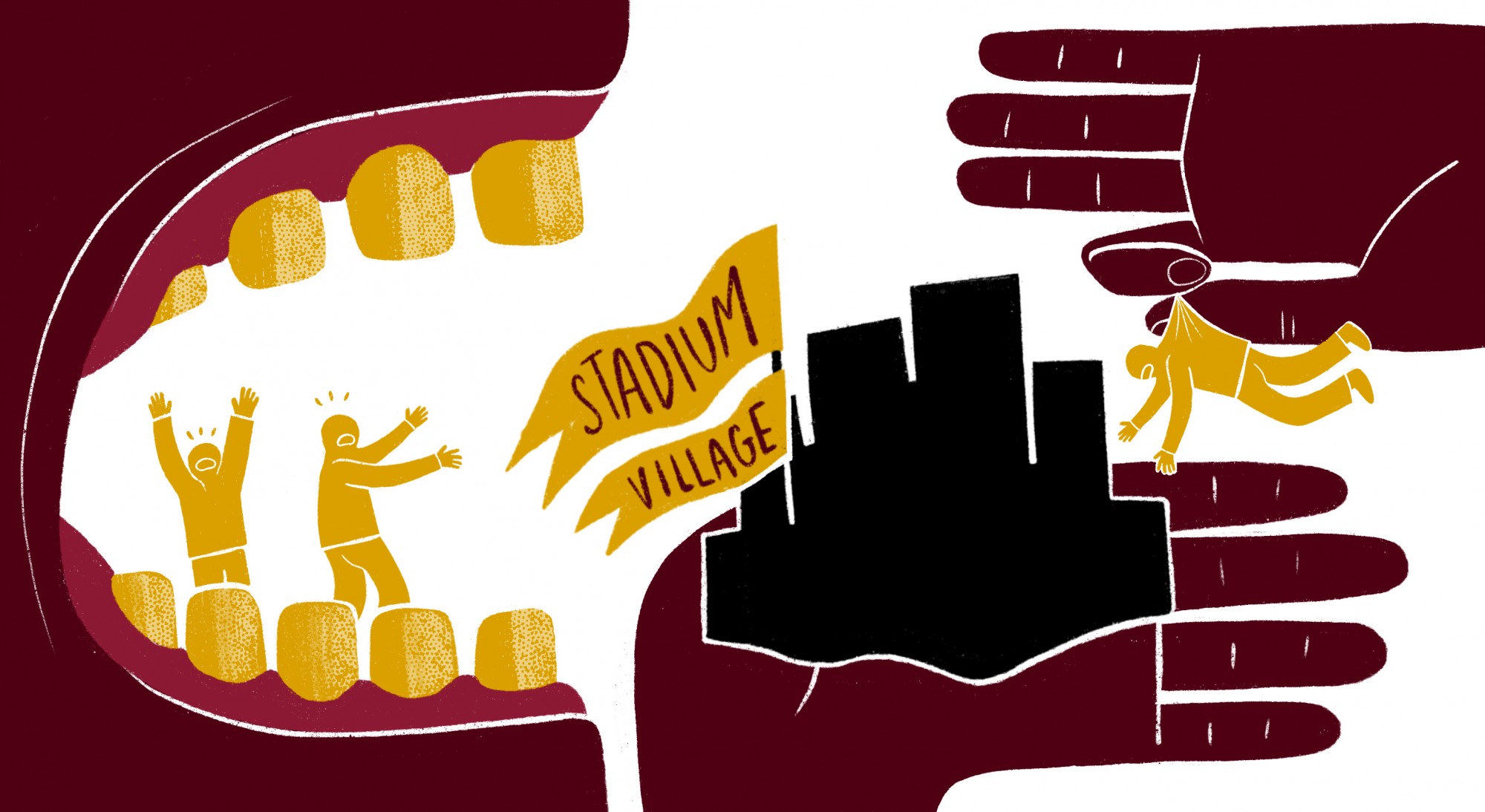A Board of Regents vote earlier this month furthers a redevelopment plan that will completely transform the Stadium Village area.
The East Gateway Project, a plan led by a University of Minnesota Foundation partnership, aims to forge an entry from the Prospect Park neighborhood and Interstate-94 into the University of Minnesota. Following years of planning, the vote transferred control of key land to UMF. The decades-long vision encompasses 3-million square feet of mixed-use development, including small-business incubators and office, residential and green space.
Regents signed off on the vision and an agreement to transfer three University-owned land parcels south of TCF Bank Stadium to UMF at the February meeting.
Both regents and University leaders have praised the project, which has also garnered criticism over the recent vote’s timeline and possible long-term effects on the region.
“This is a hundred-year decision and certainly with billions of dollars at stake,” said Regent Darrin Rosha at the Feb. 14 regents meeting. “This is a big deal.”
‘A place in need of a new identity’
The East Gateway Project is led by Visus, a partnership between the UMF subsidiary University of Minnesota Real Estate Advisors and developer Marquette, LLC. Marquette is run by the Minnesota-based multibillion-dollar Pohlad family.
Redevelopment will encompass multiple UMF-controlled properties along Washington Avenue — including the site of Stub and Herb’s — and the Dinnaken student housing properties. In that region, ValU Liquors, MyBurger and a few other parcels are still privately owned.
Years of development from separate private entities has created an unconnected, fragmented district, said Kathy Schmidlkofer, president and CEO of UMF, at the meeting. The University’s eastern boundary is “in need of a new identity,” she said.
“The private sector wants to be here. But with our help and aspirations, we can build something that’s more than one plus one,” Schmidlkofer said at the meeting. “More than incremental development. Something connected to a larger aspiration for this campus.”
UMF will have to move infrastructure in the area, including Fire Station 19 currently on Ontario Street and the University’s Internet Technologies hub and stormwater pond on University Avenue. The agreement ensures the University will not absorb these costs.
In exchange for the University parcels, UMF offered land west of Huron Boulevard, bounded by Delaware and Essex streets. This helps further the University’s plan to expand its clinical facilities.
Visus intends to work with one or more private developers, though none have yet been decided, said UMF spokesperson Sarah Youngerman.
A long process comes to a head
University stakeholders have eyed the area for redevelopment for years, yet some regents felt the vote was rushed.
The Visus partnership first unveiled initial plans more than a year ago at a Prospect Park Association meeting, and later at an October 2018 regents meeting. At the time, many regents expressed excitement about the discussion, but there was some confusion about the vision.
Then last December, Schmidlkofer and UMF’s trustee board chair Lynn Casey presented a concept plan for review with the regents.
At the recent February meeting, the plan was brought forward for both review and a vote, including dense legal agreements that turned over nearly all regent oversight of the project. Regent Michael Hsu said the agreements were provided about a week ahead of the final decision.
“So one of my concerns… is that we’re having to make decisions right now without having time to evaluate this thing in a bigger picture,” said Regent Randy Simonson at the meeting. “We have to vote on the proposal as it’s presented to us.”
UMF trustees needed regents to make a prompt decision so the project could proceed on time, Youngerman said.
Casey said UMF is creating a special committee with regent-appointed members to regularly report to the board. UMF is also currently working out clarifications to retain some regent oversight.
Concerns over conflicts of interest
With more than 90% of eligible trustees voting, UMF unanimously approved bringing the plan to regents. Some regents also sit on UMF’s Board of Trustees, including Regents Richard Beeson, Thomas Anderson and David McMillan — leading others to mention concerns over conflicts of interest.
Beeson, Anderson and McMillan did not vote as trustees for approval to bring the project to the board, Youngerman said. But they later voted in favor of the project as regents at the February meeting.
“I think it’s really more a matter of transparency and having agreements publicly debated,” Beeson said.
With the transaction moving into the hands of private entities, some discussions can happen behind closed doors. On the other hand, regents are a public governing body whose actions are subject to public scrutiny.
As a private nonprofit, UMF has a legal obligation to fulfill its mission of furthering the University’s interests.
But Hsu said UMF’s presentation didn’t seem like they sought a partnership with the regents.
“They kept on saying, ‘Well, our board already approved this unanimously.’ I don’t think they really think they sounded stupid, but they did,” Hsu said in an interview with the Minnesota Daily. “It was disingenuous.”
Uncertainty of private partnerships near campus
Rosha said at the meeting while he trusts the UMF, he’s still unsure about partnerships with private developers.
“I’m more concerned about the fact that this is not just the Foundation that’s going to be running this, it’s going to be private developers with a for-profit motive,” he said.
While private developers are familiar with city planning requirements, working with regents is unknown territory, Youngerman said. Regent oversight could scare developers with interest in the project, she said.
With private development around the University area favoring luxury student apartments, losing the Dinnaken House — to be demolished later in the project — would be detrimental for affordable student housing, Hsu said.
But Casey said the redevelopment plan is the step in the right direction for the area.
“Students today are going to come back to campus, one, two, even three decades from now. And they’re going to see a different and even better place than where you all went to school,” she said. “The University campus area is always evolving, but East Gateway that’s really an evolution with a capital E.”






















